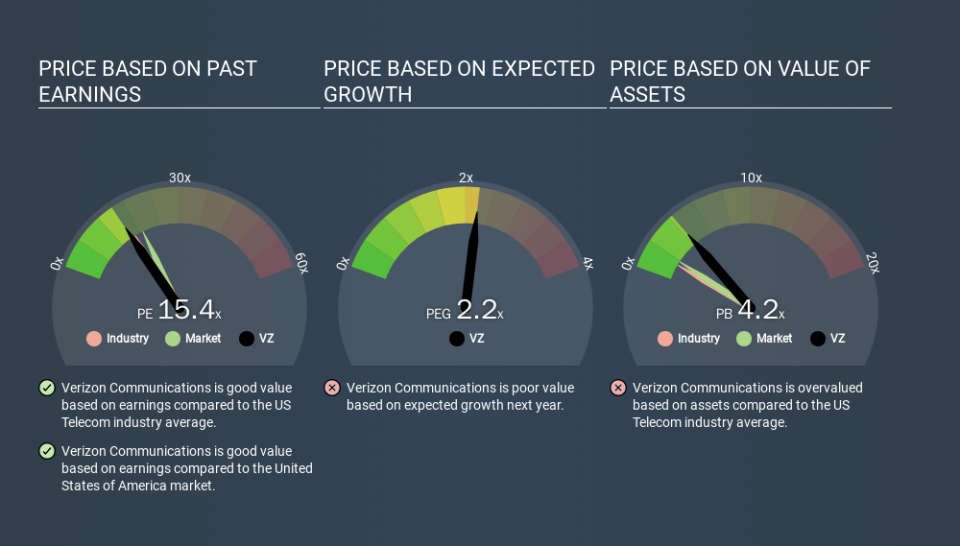Read This Before You Buy Verizon Communications Inc. (NYSE:VZ) Because Of Its P/E Ratio

This article is written for those who want to get better at using price to earnings ratios (P/E ratios). We'll show how you can use Verizon Communications Inc.'s (NYSE:VZ) P/E ratio to inform your assessment of the investment opportunity. Based on the last twelve months, Verizon Communications's P/E ratio is 15.44. In other words, at today's prices, investors are paying $15.44 for every $1 in prior year profit.
Check out our latest analysis for Verizon Communications
How Do You Calculate Verizon Communications's P/E Ratio?
The formula for price to earnings is:
Price to Earnings Ratio = Share Price ÷ Earnings per Share (EPS)
Or for Verizon Communications:
P/E of 15.44 = USD60.13 ÷ USD3.89 (Based on the trailing twelve months to September 2019.)
Is A High Price-to-Earnings Ratio Good?
A higher P/E ratio implies that investors pay a higher price for the earning power of the business. All else being equal, it's better to pay a low price -- but as Warren Buffett said, 'It's far better to buy a wonderful company at a fair price than a fair company at a wonderful price'.
How Does Verizon Communications's P/E Ratio Compare To Its Peers?
We can get an indication of market expectations by looking at the P/E ratio. The image below shows that Verizon Communications has a P/E ratio that is roughly in line with the telecom industry average (16.5).
That indicates that the market expects Verizon Communications will perform roughly in line with other companies in its industry. The company could surprise by performing better than average, in the future. Further research into factors such as insider buying and selling, could help you form your own view on whether that is likely.
How Growth Rates Impact P/E Ratios
Earnings growth rates have a big influence on P/E ratios. When earnings grow, the 'E' increases, over time. And in that case, the P/E ratio itself will drop rather quickly. So while a stock may look expensive based on past earnings, it could be cheap based on future earnings.
Verizon Communications shrunk earnings per share by 50% over the last year. But over the longer term (3 years), earnings per share have increased by 4.2%. And it has shrunk its earnings per share by 3.4% per year over the last five years. This could justify a pessimistic P/E.
Remember: P/E Ratios Don't Consider The Balance Sheet
It's important to note that the P/E ratio considers the market capitalization, not the enterprise value. Thus, the metric does not reflect cash or debt held by the company. Hypothetically, a company could reduce its future P/E ratio by spending its cash (or taking on debt) to achieve higher earnings.
Such expenditure might be good or bad, in the long term, but the point here is that the balance sheet is not reflected by this ratio.
Verizon Communications's Balance Sheet
Verizon Communications has net debt equal to 43% of its market cap. While that's enough to warrant consideration, it doesn't really concern us.
The Verdict On Verizon Communications's P/E Ratio
Verizon Communications has a P/E of 15.4. That's below the average in the US market, which is 19.0. With only modest debt, it's likely the lack of EPS growth at least partially explains the pessimism implied by the P/E ratio.
When the market is wrong about a stock, it gives savvy investors an opportunity. If it is underestimating a company, investors can make money by buying and holding the shares until the market corrects itself. So this free visual report on analyst forecasts could hold the key to an excellent investment decision.
But note: Verizon Communications may not be the best stock to buy. So take a peek at this free list of interesting companies with strong recent earnings growth (and a P/E ratio below 20).
If you spot an error that warrants correction, please contact the editor at editorial-team@simplywallst.com. This article by Simply Wall St is general in nature. It does not constitute a recommendation to buy or sell any stock, and does not take account of your objectives, or your financial situation. Simply Wall St has no position in the stocks mentioned.
We aim to bring you long-term focused research analysis driven by fundamental data. Note that our analysis may not factor in the latest price-sensitive company announcements or qualitative material. Thank you for reading.

 Yahoo Finance
Yahoo Finance 
